A Study on Mechanical and Microstructural Characteristics of Concrete Using Recycled Aggregate
Abstract
1. Introduction
2. Experimental Program
2.1. Materials
2.2. Physical Properties Studied
2.3. Granulometric Distribution of Aggregates (NA and MCRA)
2.4. Mix Design
3. Results and Discussion
3.1. Hardened Concrete Properties
3.1.1. Compressive Strength
| SI. No | Mix ID | CS (N/mm2) | CS (N/mm2) | CS (N/mm2) | CS (N/mm2) | Dry Density (kg/m3) | ||||
|---|---|---|---|---|---|---|---|---|---|---|
| (7 Days) | (28 Days) | (56 Days) | (90 Days) | |||||||
| 1 | M1 | 30.74 | +11.01 | 45.95 | +6.98 | 51.44 | +6.19 | 58.10 | +14.23 | 2461.04 |
| 2 | M2 | 26.84 | −3.07 | 35.40 | −17.58 | 42.13 | −13.03 | 46.64 | −8.3 | 2462.22 |
| 3 | M3 | 26.75 | −3.4 | 34.92 | −18.7 | 39.72 | −18 | 42.34 | −16.75 | 2492.15 |
| 4 | control | 27.69 | - | 42.95 | - | 48.44 | - | 50.86 | - | 2532.74 |
3.1.2. Split Tensile and Flexural Strength
3.1.3. Nondestructive Testing
3.2. Scanning Electron Microscopy with Energy-Dispersive Spectroscopy


3.3. X-ray Diffraction
3.3.1. Hydrated Samples at 7 Days
3.3.2. Hydrated Samples at 28 Days
3.4. Fourier Transform Infrared Spectroscopy
3.4.1. Hydrated Samples at 7 Days
3.4.2. Hydrated Samples at 28 Days
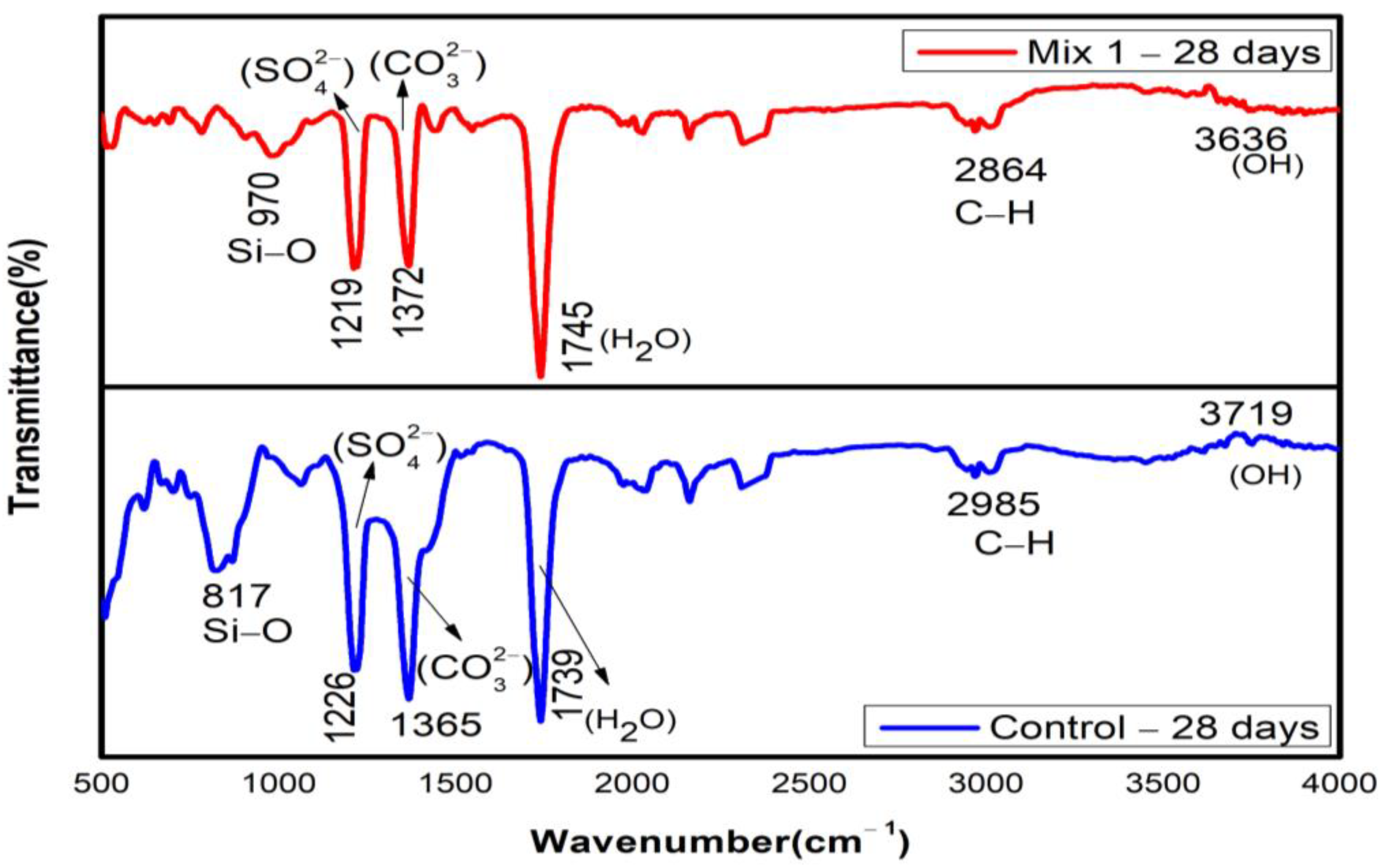
4. Conclusions
- Coarse recycled aggregate satisfied the physical parameters specified in IS 383:2016 for the production of concrete.
- The incorporation of coarse recycled aggregates in concrete showed a slump value around 75 ± 20 mm.
- The fresh concrete properties of density with 100% recycled aggregate concrete slightly decreased at a percentage of 2.33%. This behavior was the same for the concrete in fresh and hardened stages.
- The concrete with 30% replacement of MCRA showed increases of 11.01, 6.98, 6.19, and 14.23% at 7, 28, 56, and 90 days, respectively, in comparison with the control mix. Similarly, concrete with 30% replacement of MCRA showed improved split tensile and flexural strengths by about 2.92 and 6.26%, respectively.
- The ultrasonic pulse velocity (UPV) was observed as 4495 m/s for 30% of MCRA, which is recommended as excellent by IS 516 (Part 5/sec1): 2018.
- At 28 days, concrete with 30% incorporation of MCRA and the control mix had rebound numbers of 32 and 36, respectively.
- Scanning Electron Microscopy (SEM) investigations revealed a denser microstructure of recycled aggregate concrete at 30% replacement.
- The mineralogical characterization by X-ray diffraction revealed that the phases found in the recycled aggregates were calcium silicate hydrate, quartz, portlandite, and calcite in the required intensity.
- Due to silicate polymerization and the development of calcium silicate hydrate gel, the primary peak at 817 cm−1 changed to a higher frequency 970 cm−1 for the optimum mix as hydration advanced.
Author Contributions
Funding
Institutional Review Board Statement
Informed Consent Statement
Data Availability Statement
Acknowledgments
Conflicts of Interest
References
- Building Materials and Technology Promotion Council. Utilisation of Recycled Produce of Construction & Demolition Waste: A Ready Reckoner; BMTPC: New Delhi, India, 2018. [Google Scholar]
- Sun, D.; Huang, W.; Liu, K.; Ma, R.; Wang, A.; Guan, Y.; Shen, S. Effect of the Moisture Content of Recycled Aggregate on the Mechanical Performance and Durability of Concrete. Materials 2022, 15, 6299. [Google Scholar] [CrossRef] [PubMed]
- Mwasha, A.; Ramnath, R. Manufacturing Concrete with High Compressive Strength Using Recycled Aggregates. J. Mater. Civ. Eng. 2018, 30, 1–10. [Google Scholar] [CrossRef]
- Ozbakkaloglu, T.; Gholampour, A.; Xie, T. Mechanical and Durability Properties of Recycled Aggregate Concrete: Effect of Recycled Aggregate Properties and Content. J. Mater. Civ. Eng. 2018, 30, 04017275. [Google Scholar] [CrossRef]
- Makul, N. Modified Cost-Benefit Analysis of the Production of Ready-Mixed Self-Consolidating Concrete Prepared with a Recycled Concrete Aggregate. J. Constr. Eng. Manag. 2021, 147, 04021021. [Google Scholar] [CrossRef]
- Kim, J. Influence of quality of recycled aggregates on the mechanical properties of recycled aggregate concretes: An overview. Constr. Build. Mater. 2022, 328, 127071. [Google Scholar] [CrossRef]
- Meng, T.; Lian, S.; Ying, K.; Yu, H. Feasibility study of cement-stabilized materials using 100% mixed recycled aggregates from perspectives of mechanical properties and microstructure. Rev. Adv. Mater. Sci. 2021, 60, 490–502. [Google Scholar] [CrossRef]
- Medina, C.; Zhu, W.; Howind, T.; de Rojas, M.I.S.; Frías, M. Influence of mixed recycled aggregate on the physical-mechanical properties of recycled concrete. J. Clean. Prod. 2014, 68, 216–225. [Google Scholar] [CrossRef]
- Turkyilmaz, A.; Guney, M.; Karaca, F.; Bagdatkyzy, Z.; Sandybayeva, A.; Sirenova, G. A comprehensive construction and demolition waste management model using PESTEL and 3R for construction companies operating in central Asia. Sustainability 2019, 11, 1593. [Google Scholar] [CrossRef]
- Wang, X.; Cheng, F.; Wang, Y.; Zhang, X.; Niu, H. Impact Properties of Recycled Aggregate Concrete with Nanosilica Modification. Adv. Civ. Eng. 2020, 2020, 8878368. [Google Scholar] [CrossRef]
- Velardo, P.; del Bosque, I.S.; Matías, A.; de Rojas, M.S.; Medina, C. Properties of concretes bearing mixed recycled aggregate with polymer-modified surfaces. J. Build. Eng. 2021, 38, 102211. [Google Scholar] [CrossRef]
- Pacheco, J.; de Brito, J. Recycled aggregates produced from construction and demolition waste for structural concrete: Constituents, properties and production. Materials 2021, 14, 5748. [Google Scholar] [CrossRef] [PubMed]
- Liang, C.; Ma, H.; Pan, Y.; Ma, Z.; Duan, Z.; He, Z. Chloride permeability and the caused steel corrosion in the concrete with carbonated recycled aggregate. Constr. Build. Mater. 2019, 218, 506–518. [Google Scholar] [CrossRef]
- Cantero, B.; Bravo, M.; de Brito, J.; del Bosque, I.S.; Medina, C. Assessment of the permeability to aggressive agents of concrete with recycled cement and mixed recycled aggregate. Appl. Sci. 2021, 11, 3856. [Google Scholar] [CrossRef]
- Junyong, W.U.; Yunsheng, Z.; Pinghua, Z.H.U.; Jincai, F.; Kun, H.U. Mechanical Properties and ITZ Microstructure of Recycled Aggregate Concrete Using Carbonated Recycled Coarse Aggregate. J. Wuhan Univ. Technol. Mater. Sci. Ed. 2018, 33, 648–653. [Google Scholar]
- Cantero, B.; del Bosque, I.S.; Matías, A.; Medina, C. Statistically significant effects of mixed recycled aggregate on the physical-mechanical properties of structural concretes. Constr. Build. Mater. 2018, 185, 93–101. [Google Scholar] [CrossRef]
- Diaz Gonzalez, M.; Caballero, P.P.; Blanco Fernandez, D.; Vidal, M.M.J.; Saez del Bosque, I.F.; Martinez, C.M. The Design and Development of Recycled Concretes in a Circular Economy Using Mixed Construction and Demolition Waste. Materials 2021, 14, 4762. [Google Scholar] [CrossRef]
- Cantero, B.; del Bosque, I.S.; Matías, A.; de Rojas, M.S.; Medina, C. Inclusion of construction and demolition waste as a coarse aggregate and a cement addition in structural concrete design. Arch. Civ. Mech. Eng. 2019, 19, 1338–1352. [Google Scholar] [CrossRef]
- Cantero, B.; Bravo, M.; de Brito, J.; del Bosque, I.S.; Medina, C. Mechanical behaviour of structural concrete with ground recycled concrete cement and mixed recycled aggregate. J. Clean. Prod. 2020, 275, 122913. [Google Scholar] [CrossRef]
- Zega, C.J.; Santillán, L.R.; Sosa, M.E.; Zaccardi, Y.A.V. Durable Performance of Recycled Aggregate Concrete in Aggressive Environments. J. Mater. Civ. Eng. 2020, 32, 03120002. [Google Scholar] [CrossRef]
- Liang, C.; Lu, N.; Ma, H.; Ma, Z.; Duan, Z. Carbonation behavior of recycled concrete with CO2-curing recycled aggregate under various environments. J. CO2 Util. 2020, 39, 101185. [Google Scholar] [CrossRef]
- Singh, M.; Roy, A.D.; Waseem, S.; Singh, H. Feasibility and performance analysis of carbonated recycled aggregate concrete. Int. J. Sustain. Eng. 2021, 14, 761–775. [Google Scholar] [CrossRef]
- Saravanakumar, P.; Abhiram, K.; Manoj, B. Properties of treated recycled aggregates and its influence on concrete strength characteristics. Constr. Build. Mater. 2016, 111, 611–617. [Google Scholar] [CrossRef]
- Pawluczuk, E.; Kalinowska-Wichrowska, K.; Bołtryk, M.; Jiménez, J.R.; Fernández, J.M. The influence of heat and mechanical treatment of concrete rubble on the properties of recycled aggregate concrete. Materials 2019, 12, 367. [Google Scholar] [CrossRef] [PubMed]
- Purushothaman, R.; Amirthavalli, R.R.; Karan, L. Influence of Treatment Methods on the Strength and Performance Characteristics of Recycled Aggregate Concrete. J. Mater. Civ. Eng. 2015, 27. [Google Scholar] [CrossRef]
- Yunusa, M.; Zhang, X.; Cui, P.; Tian, X. Durability of Recycled Concrete Aggregates Prepared with Mechanochemical and Thermal Treatment. Materials 2022, 15, 5792. [Google Scholar] [CrossRef]
- Qin, D.; Dong, C.; Zong, Z.; Guo, Z.; Xiong, Y.; Jiang, T. Shrinkage and Creep of Sustainable Self-Compacting Concrete with Recycled Concrete Aggregates, Fly Ash, Slag, and Silica Fume. J. Mater. Civ. Eng. 2022, 34, 04022236. [Google Scholar] [CrossRef]
- Singh, R.B.; Singh, B. Rheology of High-Volume Fly Ash Self-Compacting Recycled Aggregate Concrete. J. Mater. Civ. Eng. 2021, 33, 04021280. [Google Scholar] [CrossRef]
- Nanayakkara, O.; Gunasekara, C.; Law, D.W.; Xia, J.; Setunge, S. Alkali-Activated Slag Concrete with Recycled Aggregate: Long-Term Performance. J. Mater. Civ. Eng. 2021, 33, 04021167. [Google Scholar] [CrossRef]
- Devi, S.C.; Khan, R.A. Effect of Sulfate Attack and Carbonation in Graphene Oxide–Reinforced Concrete Containing Recycled Concrete Aggregate. J. Mater. Civ. Eng. 2020, 32, 04020339. [Google Scholar] [CrossRef]
- Zhang, L.; Sojobi, A.; Kodur, V.; Liew, K.M. Effective utilization and recycling of mixed recycled aggregates for a greener environment. J. Clean. Prod. 2019, 236, 117600. [Google Scholar] [CrossRef]
- Butler, L.; West, J.; Tighe, S. The effect of recycled concrete aggregate properties on the bond strength between RCA concrete and steel reinforcement. Cem. Concr. Res. 2011, 41, 1037–1049. [Google Scholar] [CrossRef]
- Rao, G.; Prasad, B. Influence of the roughness of aggregate surface on the interface bond strength. Cem. Concr. Res. 2002, 32, 253–257. [Google Scholar] [CrossRef]
- Meng, T.; Wei, H.; Yang, X.; Zhang, B.; Zhang, Y.; Zhang, C. Effect of mixed recycled aggregate on the mechanical strength and microstructure of concrete under different water cement ratios. Materials 2021, 14, 2631. [Google Scholar] [CrossRef] [PubMed]
- Ferreira, R.L.; Anjos, M.A.; Ledesma, E.F.; Pereira, J.E.; Nóbrega, A.K. Evaluation of the physical-mechanical properties of cement-lime based masonry mortars produced with mixed recycled aggregates. Mater. Constr. 2020, 70, 210. [Google Scholar] [CrossRef]
- Etxeberria, M.; Gonzalez-Corominas, A. The assessment of ceramic and mixed recycled aggregates for high strength and low shrinkage concretes. Mater. Struct. Constr. 2018, 51, 129. [Google Scholar] [CrossRef]
- de Oliveira Andrade, J.J.; Possan, E.; Squiavon, J.Z.; Ortolan, T.L.P. Evaluation of mechanical properties and carbonation of mortars produced with construction and demolition waste. Constr. Build. Mater. 2018, 161, 70–83. [Google Scholar] [CrossRef]
- Jian, S.-M.; Wu, B. Compressive behavior of compound concrete containing demolished concrete lumps and recycled aggregate concrete. Constr. Build. Mater. 2021, 272, 121624. [Google Scholar] [CrossRef]
- Pani, L.; Francesconi, L.; Rombi, J.; Mistretta, F.; Sassu, M.; Stochino, F. Effect of parent concrete on the performance of recycled aggregate concrete. Sustainability 2020, 12, 9399. [Google Scholar] [CrossRef]
- Silva, R.; de Brito, J.; Dhir, R. Tensile strength behaviour of recycled aggregate concrete. Constr. Build. Mater. 2015, 83, 108–118. [Google Scholar] [CrossRef]
- Tabsh, S.W.; Abdelfatah, A.S. Influence of recycled concrete aggregates on strength properties of concrete. Constr. Build. Mater. 2009, 23, 1163–1167. [Google Scholar] [CrossRef]
- Zhang, H.; Wang, Y.; Lehman, D.E.; Geng, Y.; Kuder, K. Time-dependent drying shrinkage model for concrete with coarse and fine recycled aggregate. Cem. Concr. Compos. 2020, 105, 103426. [Google Scholar] [CrossRef]
- Sierens, Z.; Vandevyvere, B.; Kyndt, L.; Tytens, G.; Li, J. Non-Destructive Testing of Recycled Aggregate Concrete. IOP Conf. Ser. Earth Environ. Sci. 2019, 290, 012032. [Google Scholar] [CrossRef]
- Kazemi, M.; Hajforoush, M.; Talebi, P.K.; Daneshfar, M.; Shokrgozar, A.; Jahandari, S.; Saberian, M.; Li, J. In-situ strength estimation of polypropylene fibre reinforced recycled aggregate concrete using Schmidt rebound hammer and point load test. J. Sustain. Cem. Mater. 2020, 9, 289–306. [Google Scholar] [CrossRef]
- Boudali, S.; Soliman, A.M.; Abdulsalam, B.; Ayed, K.; Kerdal, D.E.; Poncet, S.A. Microstructural Properties of the Interfacial Transition Zone and Strength Development of Concrete Incorporating Recycled Concrete Aggregate. Int. J. Civ. Environ. Struct. Constr. Archit. Eng. 2017, 11, 966–970. [Google Scholar]
- Poon, C.; Shui, Z.; Lam, L. Effect of microstructure of ITZ on compressive strength of concrete prepared with recycled aggregates. Constr. Build. Mater. 2004, 18, 461–468. [Google Scholar] [CrossRef]
- Rostami, V.; Shao, Y.; Boyd, A.J.; He, Z. Microstructure of cement paste subject to early carbonation curing. Cem. Concr. Res. 2012, 42, 186–193. [Google Scholar] [CrossRef]
- Kavitha, O.; Shanthi, V.; Arulraj, G.P.; Sivakumar, P. Fresh, micro- and macrolevel studies of metakaolin blended self-compacting concrete. Appl. Clay Sci. 2015, 114, 370–374. [Google Scholar] [CrossRef]
- Singh, N.; Singh, S.P. Validation of carbonation behavior of self compacting concrete made with recycled aggregates using microstructural and crystallization investigations. Eur. J. Environ. Civ. Eng. 2020, 24, 2187–2210. [Google Scholar] [CrossRef]
- Qi, B.; Gao, J.; Chen, F.; Shen, D. Evaluation of the damage process of recycled aggregate concrete under sulfate attack and wetting-drying cycles. Constr. Build. Mater. 2017, 138, 254–262. [Google Scholar] [CrossRef]
- Damrongwiriyanupap, N.; Wachum, A.; Khansamrit, K.; Detphan, S.; Hanjitsuwan, S.; Phoo-Ngernkham, T.; Sukontasukkul, P.; Li, L.-Y.; Chindaprasirt, P. Improvement of recycled concrete aggregate using alkali-activated binder treatment. Mater. Struct. Constr. 2022, 55, 11. [Google Scholar] [CrossRef]
- Yaowarat, T.; Horpibulsuk, S.; Arulrajah, A.; Mirzababaei, M.; Rashid, A.S. Compressive and Flexural Strength of Polyvinyl Alcohol–Modified Pavement Concrete Using Recycled Concrete Aggregates. J. Mater. Civ. Eng. 2018, 30, 04018046. [Google Scholar] [CrossRef]
- Rais, M.S.; Khan, R.A. Experimental investigation on the strength and durability properties of bacterial self-healing recycled aggregate concrete with mineral admixtures. Constr. Build. Mater. 2021, 306, 124901. [Google Scholar] [CrossRef]
- Barnett, S.; Macphee, D.; Lachowski, E.; Crammond, N. XRD, EDX and IR analysis of solid solutions between thaumasite and ettringite. Cem. Concr. Res. 2002, 32, 719–730. [Google Scholar] [CrossRef]
- Bulatović, V.; Melešev, M.; Radeka, M.; Radonjanin, V.; Lukić, I. Evaluation of sulfate resistance of concrete with recycled and natural aggregates. Constr. Build. Mater. 2017, 152, 614–631. [Google Scholar] [CrossRef]
- Spathi, C.; Young, N.; Heng, J.Y.Y.; Vandeperre, L.J.M.; Cheeseman, C.R. A simple method for preparing super-hydrophobic powder from paper sludge ash. Mater. Lett. 2015, 142, 80–83. [Google Scholar] [CrossRef]

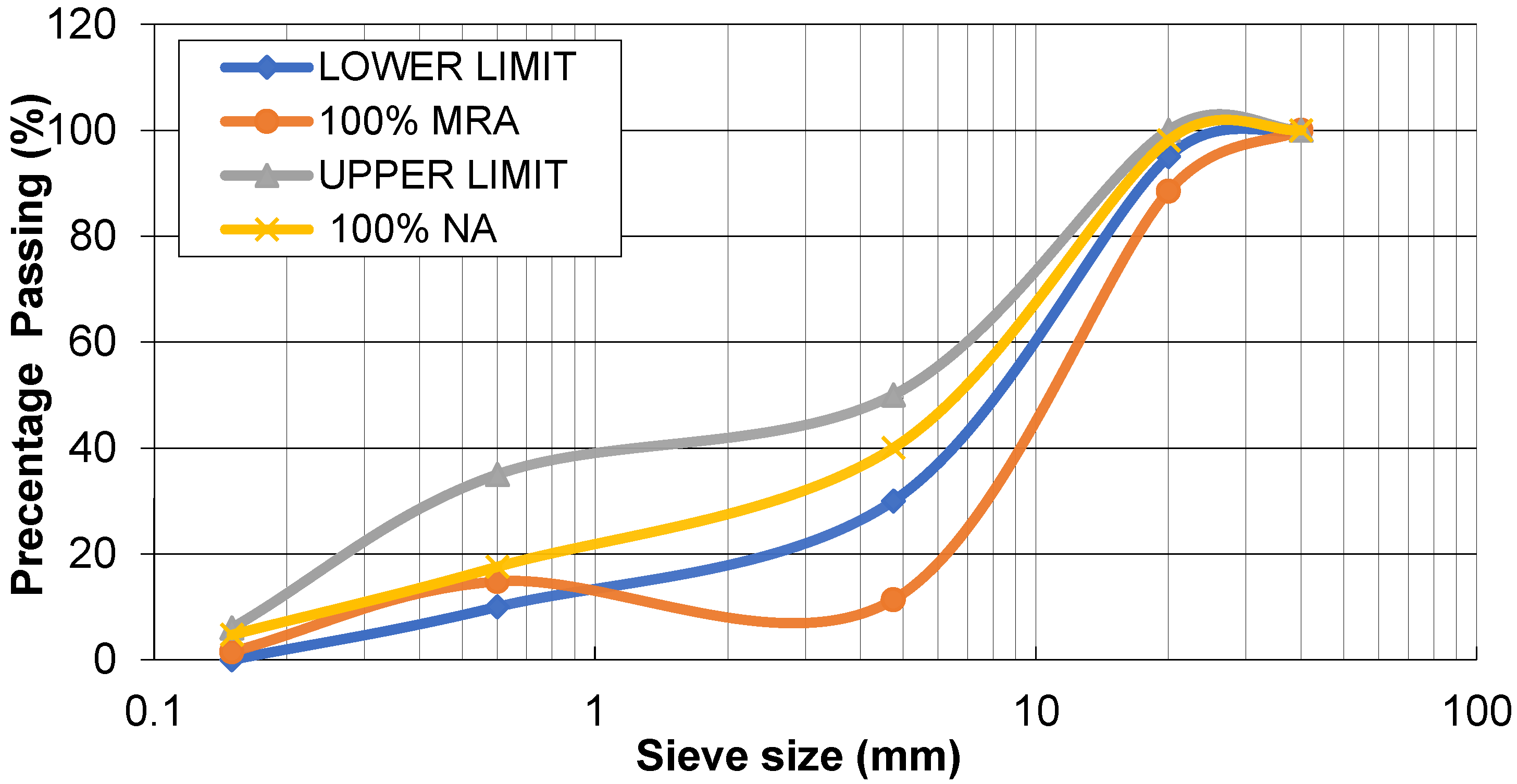
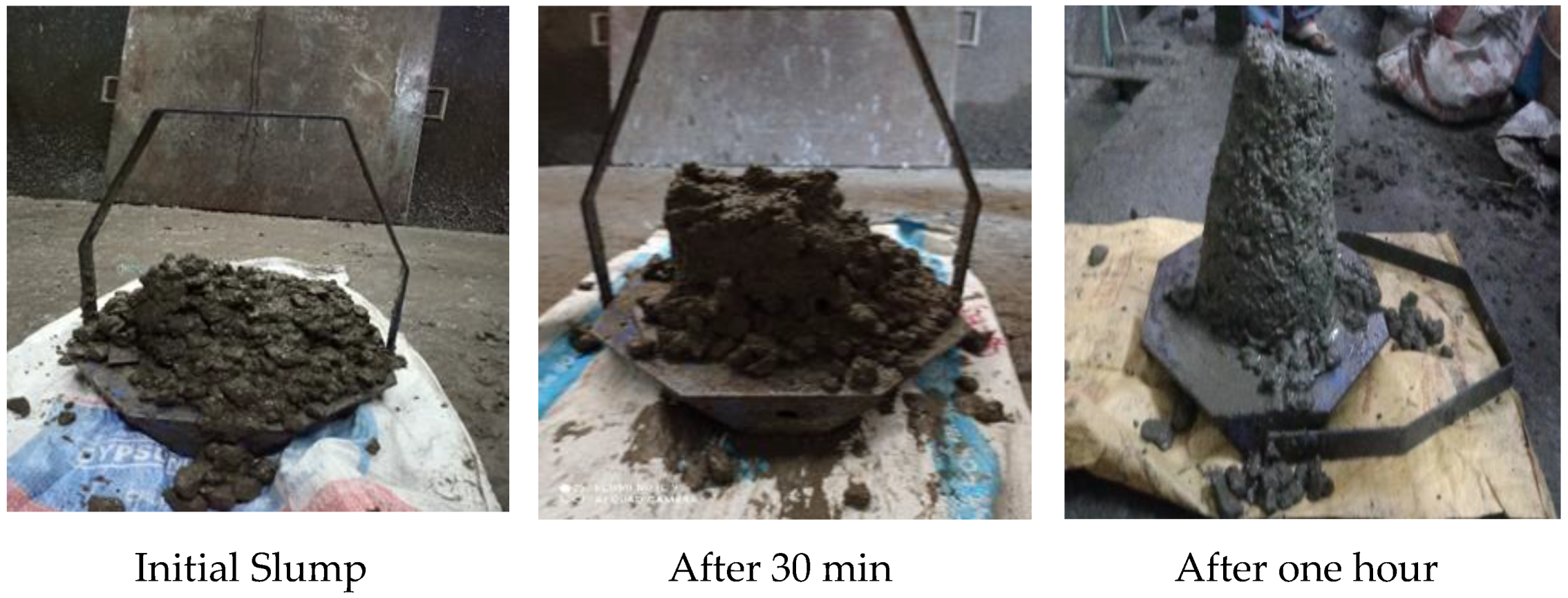
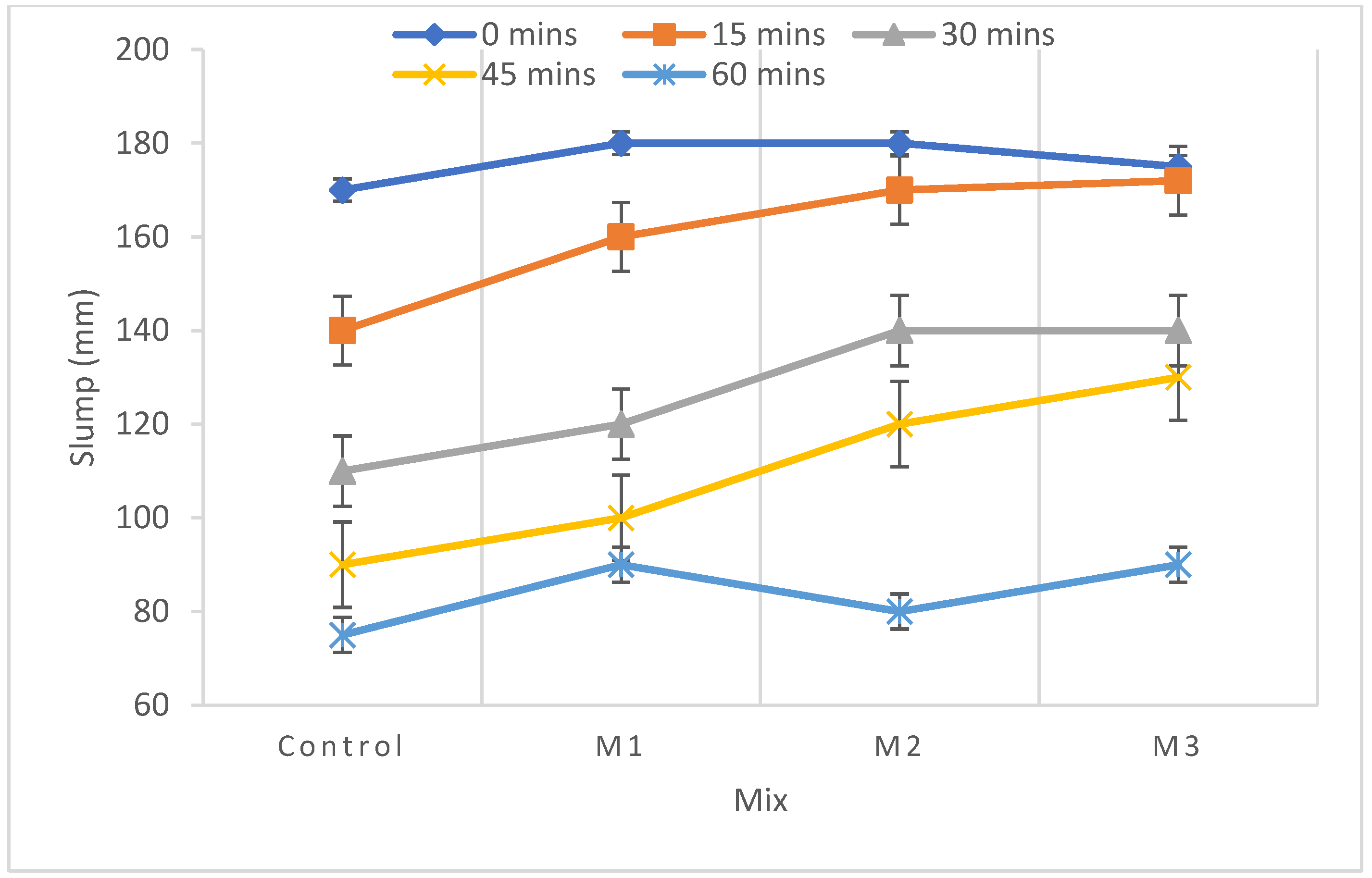

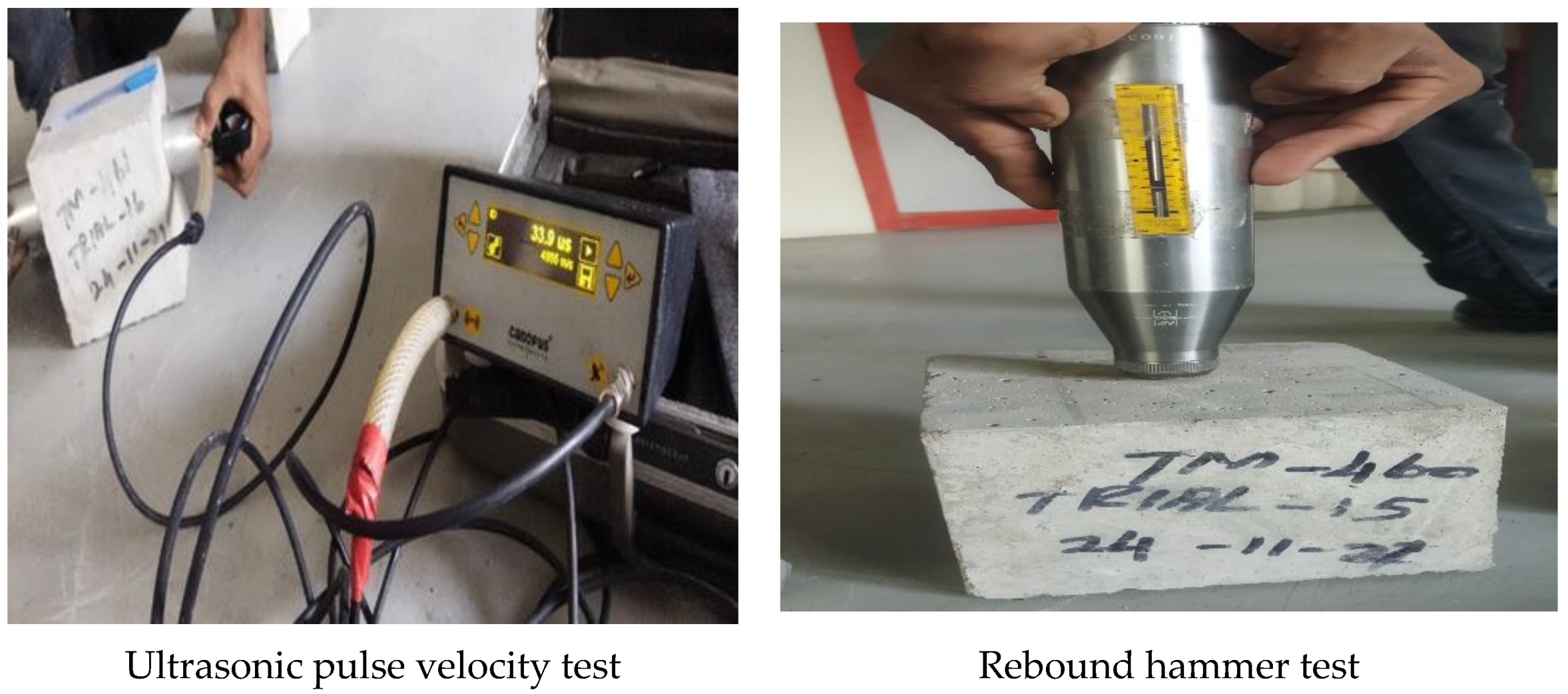

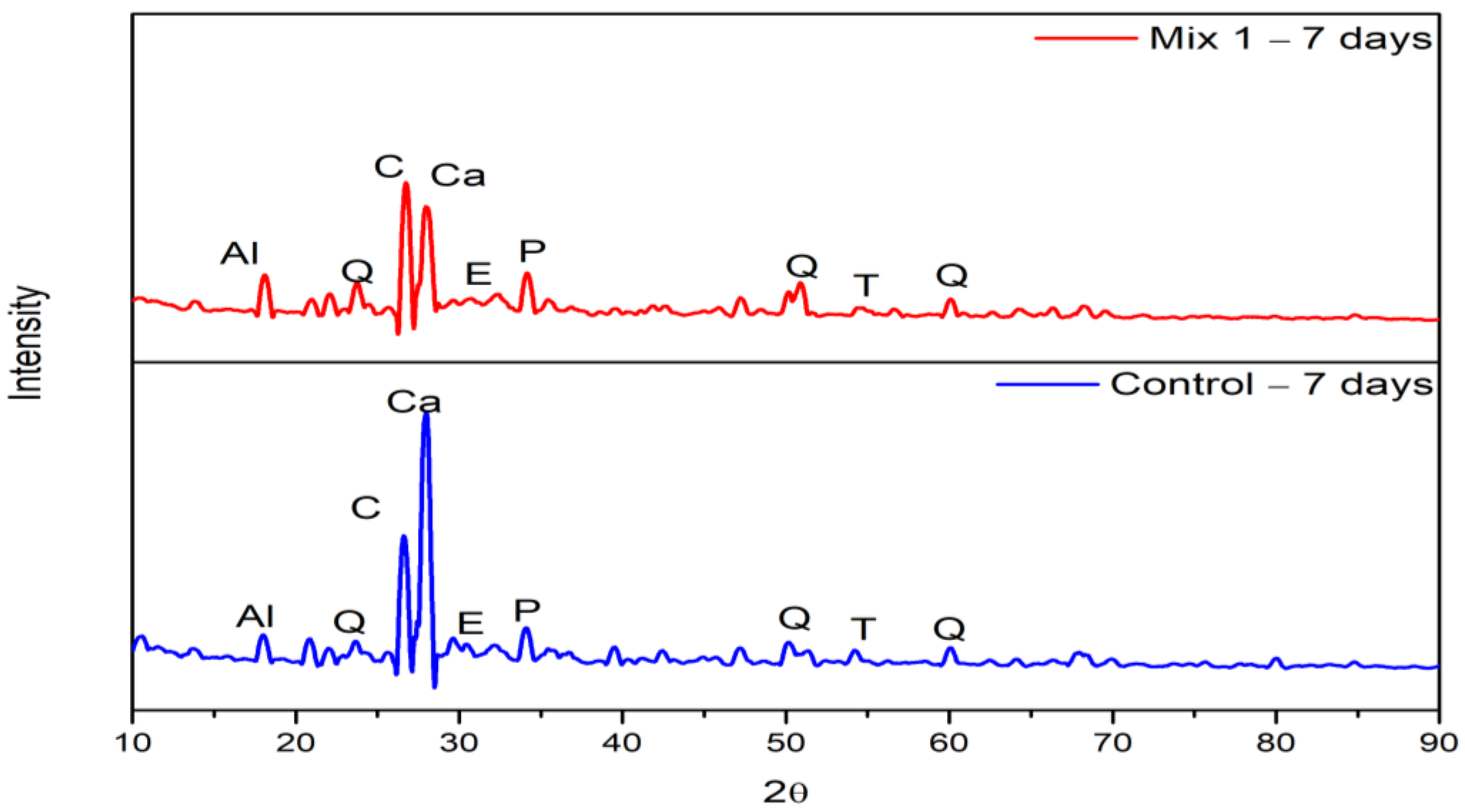
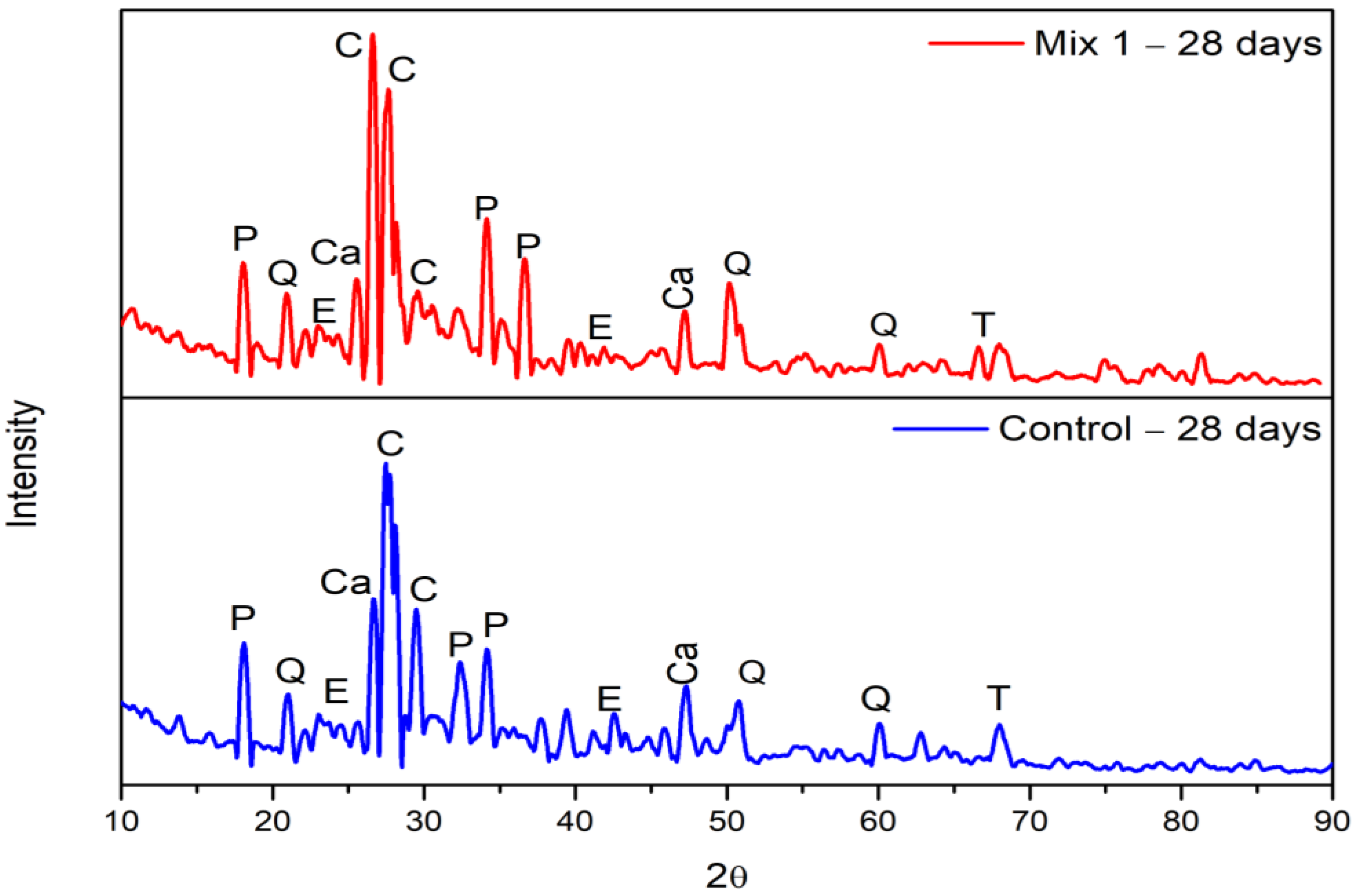

| SI.No | Properties | NCA | RCA | ||
|---|---|---|---|---|---|
| 20 mm | 12.5 mm | 20 mm | 12.5 mm | ||
| 1 | Loose air-dried bulk density (kg/m3) | 1475 | 1453 | 1319 | 1186 |
| 2 | Bulk density (Rodded) (kg/m3) | 1668 | 1642 | 1452 | 1381 |
| 3 | Specific gravity | 2.71 | 2.68 | 2.3 | 2.41 |
| 4 | Water absorption (24 h) % | 0.5 | 0.67 | 2.3 | 1.95 |
| 5 | Aggregate crushing value % | - | 16.07 | - | 31.6 |
| 6 | Aggregate impact value % | - | 13.3 | - | 27.9 |
| SI. No | Reference | Water Absorption % after 24 h and Size of Aggregates | Source of RA | |
|---|---|---|---|---|
| CMRA | FMRA | |||
| 1 | [17] | 6.28 (6–12 mm) | 5.39 (0–6 mm) | RAPLASA C&DW management plant in Cáceres (Spain). |
| 2 | [4] | 6.12 (12 mm max) | 4.08 (7 mm max) | locally in South Australia. |
| 3 | [7] | 8.5 (9.5–31.5 mm) | 21 (0–9.5 mm) | Hangzhou qianjiang new city municipal garden Construction Co., Ltd. |
| 4 | [34] | 8.7 (18–32 mm) MRA-1 | - | Zhoushan jinke resources recycling Co., Ltd. in Zhoushan, China. |
| 9.1 (10–18 mm) MRA-2 | - | |||
| 13.2 (0–18 mm) MRA-3 | - | |||
| 5 | [14] | 9.1 (4–22 mm) | - | CDW recycling plant at Lisbon (Portugal). |
| 7 | [19] | 9.1 (0–25 mm) | - | |
| 8 | [35] | 6.09 (<4.75 mm) | CDW recycling plant n São José do Mipibú Brazil. | |
| 9 | [18] | 5.27 (22/12 mm) 6.28 (12/6 mm) | - | C&DW plant in Extremadura, western Spain. |
| 10 | [36] | 17.82 | 16 | construction and demolition waste treatment plant, Spain. |
| 11 | [37] | - | 5.23 (<4.75 mm) | Collected from Porto Alegre (RS, Brazil). |
| 12 | [8] | 4.49 (<20 mm) | - | C&DW management and processing plant in Glasgow, Scotland. |
| Materials | Mix (kg/m3) | |||
|---|---|---|---|---|
| Control | M1 | M2 | M3 | |
| Cement | 380 | 380 | 380 | 380 |
| NCA (20 mm) | 697 | 488 | 279 | - |
| NCA (12 mm) | 460 | 322 | 184 | - |
| MCRA (20 mm) | - | 188 | 374 | 624 |
| MCRA (12 mm) | - | 122 | 243 | 406 |
| MSAND | 725 | 725 | 725 | 725 |
| WATER | 160 | 160 | 160 | 160 |
| Mix | Slump Value (mm) | Fresh Density (kg/m3) | Temperature (°C) |
|---|---|---|---|
| Control | 75 | 2416 | 28 |
| M1 | 90 | 2463.3 | 27 |
| M2 | 80 | 2473 | 27 |
| M3 | 90 | 2386.67 | 27 |
| SI.NO | Mix ID | Split Tensile Strength, fc (MPa) | Flexural Strength, fb (MPa) | ||
|---|---|---|---|---|---|
| 1 | M1 | 2.82 | +2.92 | 5.09 | +6.26 |
| 2 | M2 | 2.29 | −16.42 | 3.65 | −23.80 |
| 3 | M3 | 2.21 | −19.00 | 2.52 | −47.39 |
| 4 | Control | 2.74 | - | 4.79 | - |
| Si. No | Mix ID | Ultrasonic Pulse Velocity (UPV) @ 28 Days | Rebound Value | ||
|---|---|---|---|---|---|
| Velocity (m/s) | Time Taken (microseconds) | Concrete Quality | |||
| 1 | M1 | 4495 | 33.37 | Excellent | 32 |
| 2 | Control | 4655 | 32.22 | Excellent | 36 |
| Equipment | Manufacturer | PANlytical, Bruker, Rigaku |
|---|---|---|
| Model | XPERT-PRO | |
| Diffractometer Geometry | Measurement setup | Bragg–Brentano, transmission; θ–θ, θ–2θ |
| X-ray Source | Goniometer Radius (mm) X-ray radiation Generator Settings | 240 Anode Material Cu K-Alpha1 (Å): 1.54060 30 mA, 45 kV |
| Scan parameters | Size (°2Th.) Scan Time (s) Type Scan Axis | 0.0200 1.0000 Continuous Gonio |
| SI.No | Mix | Phase | Pos. (°2Th.) | Height (cts) | FWHMLeft (°2Th.) | d-Spacing (Å) | Rel. Int. (%) |
|---|---|---|---|---|---|---|---|
| 1 | Mix 1 | CSH | 26.7163 | 398.17 | 0.1181 | 3.33409 | 100.00 |
| CaCO3 | 28.0422 | 196.89 | 0.1378 | 3.17939 | 49.45 | ||
| Ca(OH)2 | 34.1573 | 70.57 | 0.1574 | 2.62288 | 17.72 | ||
| Al2O3·3H2O | 18.1007 | 95.76 | 0.1181 | 4.89693 | 24.05 | ||
| SiO2 | 60.0231 | 41.02 | 0.0720 | 1.54006 | 10.30 | ||
| 50.8314 | 85.93 | 0.0720 | 1.79481 | 21.58 | |||
| 23.7228 | 70.35 | 0.0590 | 3.74760 | 17.67 | |||
| 2 | Control | CSH | 26.6157 | 308.31 | 0.1181 | 3.34646 | 61.22 |
| CaCO3 | 27.9707 | 503.58 | 0.1181 | 3.18735 | 100.00 | ||
| Ca(OH)2 | 34.0779 | 52.15 | 0.1574 | 2.62881 | 10.36 | ||
| Al2O3·3H2O | 18.0160 | 49.86 | 0.1181 | 4.91977 | 9.90 | ||
| SiO2 | 59.9690 | 27.89 | 0.0720 | 1.54132 | 5.54 | ||
| 50.1300 | 39.33 | 0.0720 | 1.81826 | 7.81 | |||
| 23.5069 | 26.79 | 0.1968 | 3.78152 | 5.32 |
| SI. No | Mix | Phase | Pos. (°2Th.) | Height (cts) | FWHMLeft (°2Th.) | d-Spacing (Å) | Rel. Int. (%) |
|---|---|---|---|---|---|---|---|
| 1 | Mix 1 | CSH | 27.4555 | 198.56 | 0.0787 | 3.24598 | 100.00 |
| CaCO3 | 26.6737 | 185.10 | 0.0787 | 3.33932 | 93.22 | ||
| 47.1950 | 25.50 | 0.1968 | 31.92426 | 49.45 | |||
| Ca(OH)2 | 18.0747 | 89.26 | 0.0787 | 4.90393 | 44.95 | ||
| 34.0967 | 79.89 | 0.0787 | 2.62741 | 40.24 | |||
| 36.5634 | 96.23 | 0.0590 | 2.45561 | 48.46 | |||
| Quartz | 50.1765 | 66.24 | 0.0720 | 1.81668 | 33.36 | ||
| 20.8716 | 52.68 | 0.0787 | 4.25266 | 26.53 | |||
| 2 | Control | CSH | 27.4368 | 280.59 | 0.1181 | 3.24815 | 100.00 |
| CaCO3 | 26.7069 | 101.37 | 0.0787 | 3.33525 | 36.13 | ||
| 47.1204 | 32.29 | 0.1574 | 1.92713 | 11.51 | |||
| Ca(OH)2 | 18.0999 | 88.34 | 0.0984 | 4.89713 | 31.48 | ||
| 34.1388 | 43.47 | 0.1968 | 2.62426 | 15.49 | |||
| 37.7077 | 35.93 | 0.0590 | 2.38368 | 12.81 | |||
| Quartz | 50.6358 | 18.08 | 0.2362 | 1.80128 | 6.44 | ||
| 21.0258 | 33.66 | 0.1968 | 4.22182 | 12.00 |
Publisher’s Note: MDPI stays neutral with regard to jurisdictional claims in published maps and institutional affiliations. |
© 2022 by the authors. Licensee MDPI, Basel, Switzerland. This article is an open access article distributed under the terms and conditions of the Creative Commons Attribution (CC BY) license (https://creativecommons.org/licenses/by/4.0/).
Share and Cite
Joseph, H.S.; Pachiappan, T.; Avudaiappan, S.; Flores, E.I.S. A Study on Mechanical and Microstructural Characteristics of Concrete Using Recycled Aggregate. Materials 2022, 15, 7535. https://doi.org/10.3390/ma15217535
Joseph HS, Pachiappan T, Avudaiappan S, Flores EIS. A Study on Mechanical and Microstructural Characteristics of Concrete Using Recycled Aggregate. Materials. 2022; 15(21):7535. https://doi.org/10.3390/ma15217535
Chicago/Turabian StyleJoseph, Herbert Sinduja, Thamilselvi Pachiappan, Siva Avudaiappan, and Erick I. Saavedra Flores. 2022. "A Study on Mechanical and Microstructural Characteristics of Concrete Using Recycled Aggregate" Materials 15, no. 21: 7535. https://doi.org/10.3390/ma15217535
APA StyleJoseph, H. S., Pachiappan, T., Avudaiappan, S., & Flores, E. I. S. (2022). A Study on Mechanical and Microstructural Characteristics of Concrete Using Recycled Aggregate. Materials, 15(21), 7535. https://doi.org/10.3390/ma15217535





